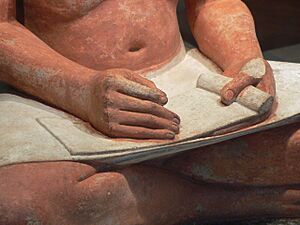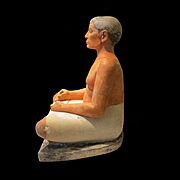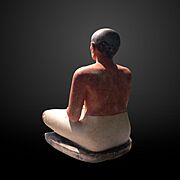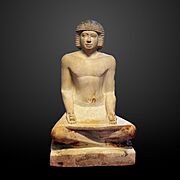The Seated Scribe facts for kids
Quick facts for kids The Seated Scribe |
|
|---|---|
| pika | |
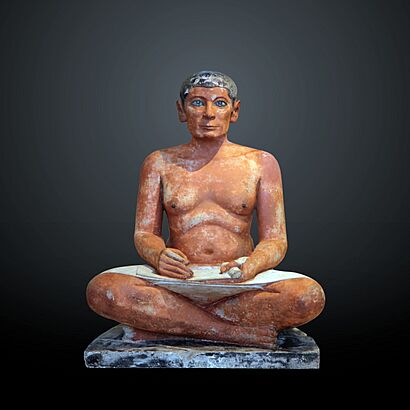 |
|
| Medium | limestone |
| Dimensions | 53.7 cm (21.1 in) × 44 cm (17 in) × 35 cm (14 in) |
| Location | Louvre-Lens, Louvre-Lens Glass Pavilion, Room 635, Egypt |
| Owner | French State |
| Collection | Department of Egyptian Antiquities of the Louvre |
| Accession No. | E 3023 |
The sculpture known as The Seated Scribe is a very famous piece of ancient Egyptian art. It shows a scribe (a person who wrote things down) sitting and working. This amazing statue was found in Saqqara, Egypt, in 1850.
Experts believe it was made during the Old Kingdom period. This was either in the 5th Dynasty (around 2450–2325 BCE) or the 4th Dynasty (around 2620–2500 BCE). Today, you can see The Seated Scribe at the Louvre museum in Paris, France.
The statue is made from painted limestone. Its eyes are very special. They are made with rock crystal, magnesite (a type of mineral), and a mix of copper and arsenic.
Contents
What the Seated Scribe Looks Like
This painted limestone statue shows a man sitting down. He is likely a scribe, ready to write. The figure wears a white kilt, which is a type of skirt, that reaches his knees. He holds a scroll of papyrus (an ancient type of paper) that is partly rolled up.
One of the most interesting parts of the statue is its face. The face looks very realistic, showing many details. This is different from the rest of his body, which is a bit simpler. The hands, fingers, and even fingernails are carefully shaped. His hands are placed as if he is about to write.
The Scribe's Detailed Eyes
The eyes of the sculpture were made with great care. They are crafted from pieces of white magnesite that have red lines in them. These pieces were carefully set with polished, cut rock crystal. The back of the crystal has a layer of a natural material. This material gives the iris (the colored part of the eye) a blue color and also helps to glue the pieces in place. Two small copper clips hold each eye firmly. Fine lines of dark paint show the eyebrows.
Body and Pose
The scribe's body looks soft and a little bit overweight. This suggests that he was a wealthy person who did not need to do hard physical work. He sits with his legs crossed, which was a common way for scribes to sit while working. His face looks alert and focused. He seems to be looking at the viewer, as if waiting for them to speak.
He has a papyrus scroll ready on his lap. However, the reed brush he would use for writing is missing. Both of his hands rest on his lap. His right hand points towards the papyrus, as if he has already started writing while listening to others. He looks calmly at the viewer with his eyes outlined in black.
The Scribe's History
The statue of The Seated Scribe was found in Saqqara, Egypt, on November 19, 1850. It was discovered by a French archaeologist named Auguste Mariette. The exact spot where it was found is not known today. This is because the notes about the discovery were published after Mariette died, and his original digging diary was lost.
We do not know who the person in the statue is. The round base of the sculpture suggests it was once part of a larger stone piece. This larger piece probably had the scribe's name and job title carved on it. This special sitting pose was usually used for members of the royal family, but not for the king himself.
Dating the Statue
The statue is thought to be from the 4th Dynasty, around 2620–2500 BC. It is often linked to a person named Pehernefer. Some features of the statue, like its thin lips, wide chest, and body position, might support this idea. However, the exact date is still uncertain. Some experts think it might be from the 6th Dynasty.
One reason to believe it's from an earlier time is that the statue shows the scribe in a "writing" position. Scribes from after the 5th Dynasty were usually shown in a "reading" position.
The Importance of Scribes
The Seated Scribe was created around 2450–2325 BCE. It was found near a tomb belonging to an official named Kai. Many pharaohs (Egyptian kings) and important officials had statues or images of their servants. They believed these servants would help them in the afterlife.
Scribes were very important people in ancient Egypt. They were among the few who knew how to read and write. Because of this, they were highly respected and well-paid. Most people were farmers who did not need to read or write. While some royal family members and high-ranking people could read, scribes were needed for almost everything the government did.
Scribes had many different jobs in daily Egyptian life. They worked as tax collectors and helped organize people for activities like mining, trade, and war. Scribes also worked on big projects like building the pyramids. They helped leaders communicate with the Egyptian people.
- Details and similar works
See also
- List of ancient Egyptian scribes



